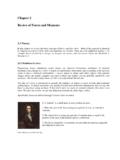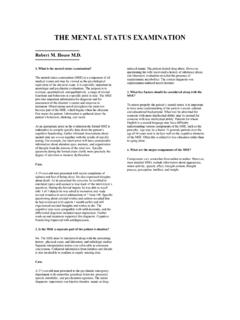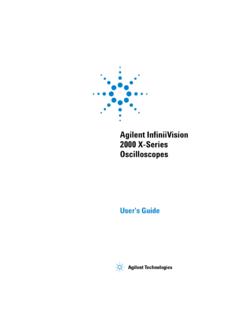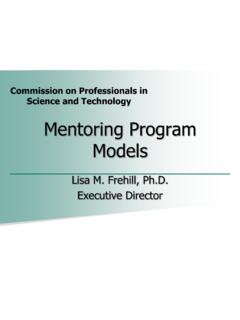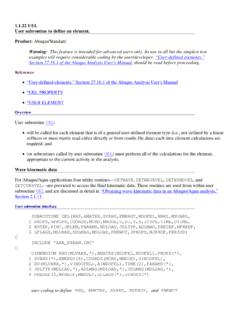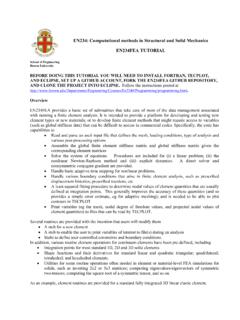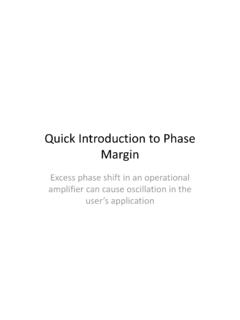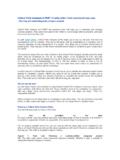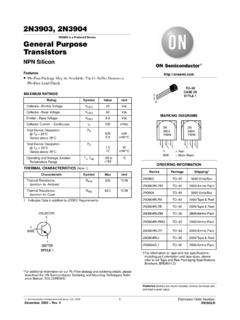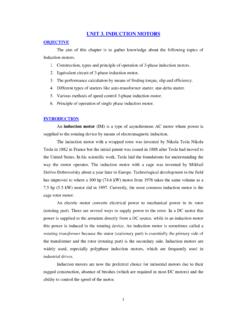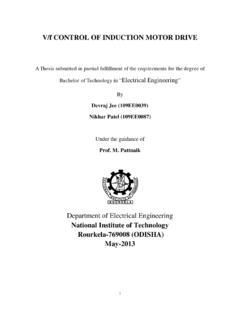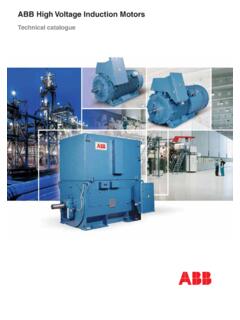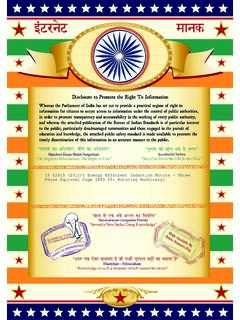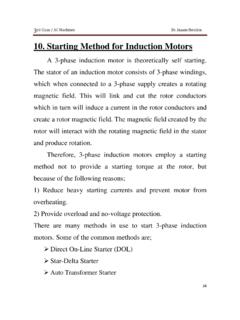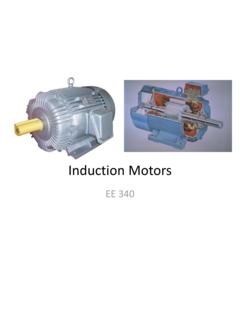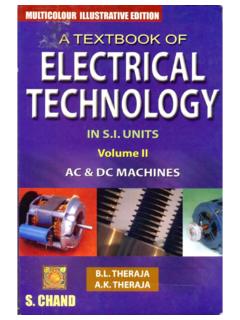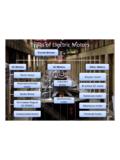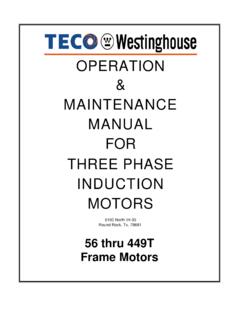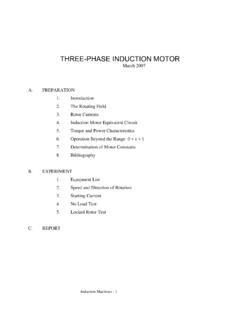Transcription of How an Induction Motor Works by Equations (and Physics)
1 How an Induction Motor Works by Equations (and Physics) Introduction: Induction motors are the commonest type of Motor and account for a very large proportion of heavy duty motors. Sizes vary from fractional horsepower to several thousand horsepower used for such appli-cations as diesel-electric locomotives. Until relatively recently most such motors had to operate at fixed speeds determined by the available line power frequency. Now the availability of power semiconductors and circuits makes it possible to vary their speed and even in some cases hold them stationary. All motors require two sets of magnetic fields, one of which might be supplied by a permanent magnet, that in-teract to drive the rotor. One field acts as a sort of environmental field and the second, a time varying field, re-acts with the first to drive the rotor. In Induction motors the environmental field is supplied by one or more coils in the stator that create a rotating B field in the air gap between rotor and stator.
2 The distinguishing feature of Induction motors is that their rotors have no permanent magnets or any need for current to be driven into the rotor windings from any direct connection. (A direct connection would require brushes, a commutator and more power supply connections, raising cost and decreasing reliability. This is why Induction motors are more popular.) Instead the rotor is wound with shorted turns in which the environmental field induces a current. That current in turn produces a field that interacts with the environment to drive the rotor. The three-phase Induction Motor is the easiest Motor of this type to understand so these notes start with that type. The single-phase Induction Motor is more subtle and less efficient. It is discussed later. The magnetic field in the air gap from the voltage applied to the stator: The stator has three sets of windings that are aligned at 120 degrees to each other and are driven by balanced currents that are 120 degrees out of phase.
3 Call the coils A, B, C and we will work in cylindrical coordinates. (See figure below.) The coils are wound in such a way as to generate a field that is a rough stepwise approximation to a cos( ) distribution. The wind-ings overlap and each winding slot has two windings in it usually from different phases. (See 4 and 6 pole distri-butions on the handout from class.) Here I assume a two pole distribution because it makes the explanation eas-ier. Such a Motor runs at the nominal speed range of 3500 3580 RPM. (Four and six pole motors run at 1720 to 1790 and 1140 to 1190 RPM respectively.) []1002cos( ) cos()cos() cos()ABBt rBtt r ==++ 2241003323cos() cos()[cos() cos()]BBBtr Btt r = =+ + 4421003323cos() cos()[cos() cos()]CBBtr Btt r = =+ + 4210233[3 cos() cos() cos() cos()]ABCB BBBB ttttr =++= ++++ ++ 302cos()BBt r = Induction Motor Equations ENGN1931F Spring 2017 2 Let and LRS be the angular velocities of the magnetic field (line frequency), rotor, and slip respectively.
4 For convenience we assume that 0 = at t = 0, which implies Rt = andSLR = . The flux in the single-turn coil on the rotor surface is 22223300022cos()cos()3cos()ROTORPEAKLSB rldB rltdB rlt ++ = = = The voltage in the loop is 03sin()ROTORSSdVB rltdt = = The current in the loop is: 0022223sin()sin()cos()3()()ROTORSSRSSRSR SLOOPRRRSRRSRVB rltRtLtiB rlZRjXRLRL === +++ For use later in calculating the heat wasted in the rotor, we will need the mean square value of this current or: ()2 2 222012229 SRRSRB r liRL =+ The B field at the leading edge of the rotor coil is: 33002222(())cos()sin()PEAKLSBBtrBt r = += = Also at the leading edge of the rotor coil, the positive sign on the voltage implies that the current is out of the page along the k axis and therefore the force on the wire from the Lorenz force law is in the k r = + direc-tion.
5 The rotor is being pushed in the direction of the rotation of the stator magnetic field. The total torque from both sides of the loop is then 22 2 202222sin ()cos() sin()9()()RSSRSSSRSRRSRRtLttTB r lkRLRL = ++ The first term in []212sin ()1 cos(2)SStt = gives a net positive average torque but it has 100 % variation in magnitude from no torque to twice the average torque at twice the slip frequency. The second term has no net average torque but would also represent vibration at twice the slip frequency. Figure 1 is a graph showing the two terms and their sum. (The slip frequency is very low, typically 20 90 RPM or to Hz, so this would be really bad vibration.) Induction Motor Equations ENGN1931F Spring 2017 3 Suppose, however, we add a second coil at a right angle to the first. The current in that loop will result in a sim-ultaneous torque that has the same functional form but with all angular arguments moved back by 2 radians.
6 Use the trigonometric identities that 2sin()cos()SStt = and 2cos() sin()SStt = to get the total torque of the two turns as: 222 2 200222929()/1 (2)SRSRSRRS RB r lfRTB r lkkRLR lf == ++ i X XXSTATOR XX - rotor angle XXROTOR - magnetic field angle r j Single turn rotor coil XXCoil A stepwise approximation to cos( ) field distribution Induction Motor Equations ENGN1931F Spring 2017 4 where /RRRLR = is the rotor time constant. This is a constant torque as shown on the median line in Fig. 1. There are two equivalent forms of the torque expression here. The first is the result of simple substitution. The second expression has been rewritten to emphasize how the torque and hence power depends on several prop-erties of the system. It is directly proportional to the square of the stator field 0B (more field induces more cur-rent and the torque is a product of field and current), to the volume of the rotor (larger motors, more torque), and to the slip frequency.
7 No slip, no torque because there will be no current in the rotor cage. Figure 1: Relative torque as a function of slip angle (St ) for a single rotor loop and for two loops at right an-gle to each other. Net torque from current in phase with the induced voltage and torque component with no net torque, just vibration, from current at 90 deg. phase angle. Notice that the torque equation implies a relationship between the size of the rotor and the mechanical power that can possibly be delivered to the load. The mechanical power is 2202()36/1 (2)LINESSMECHANICALRRS RB r l fffPTR lf = = + Induction Motor Equations ENGN1931F Spring 2017 5 For low slip frequencies, the power of the Motor is simply proportional to the product of the square of the gap field strength with the volume of the rotor and the no-load speed of rotation.
8 To increase Motor power, general-ly you have to increase the rotor volume or the speed of rotation since the B field strength is limited by the properties of magnet iron and the effective resistance of the rotor is limited by the need to cool the rotor. Figure 2 shows an evaluation of this torque expression for a 4-pole Motor with = seconds. The curve has been normalized to unit peak value to show the relation between torque and shaft speed. Mechanical pow-er is the product of torque with angular velocity and a similarly normalized power curve is superposed. Small motors are sometimes built as single phase Induction -run motors and these have no starting torque and have rather less torque for a given stator B-field. (You do experiments on two of these.) Obviously, one can increase the torque by adding more loops in pairs until reaching a limit set by the ability to get rid of heat.
9 (The rotor cage has non-zero resistance and that means joule heating anytime there is rotor cur-rent, that is, anytime there is non-zero torque.) The torque and output power increase directly proportional to the number of pairs of loops. Connecting all the ends of the axial rotor wires by a heavy ring of conductor does not influence the resulting operation very much, so motors generally have a cage-like structure for the loops in which the induced current flows. This is why the commonest Induction motors are called squirrel-cage motors since the structure looks like what might be used to entertain a small animal in captivity. (Very large motors sometimes have a portion of the ends of the rotor windings externally connected through brushes so you can control the effective resistance of the rotor. Increasing RR lowers the rotor time constant moving the peak torque to lower rotation speed and higher slip.)
10 This lowers the maximum torque too, but it substantially in-creases the starting torque. Usually on a wound-rotor Induction Motor , the external resistance is optimized for initial starting torque and then the resistor is shorted for optimal steady state operation. This procedure helps control startup current, limiting the inrush current without requiring a high leakage inductance in the stator.) There is an odd subtle feature of the thermal problem in that the rotor resistance changes very rapidly with temperature, increasing by 25 % for a 50 deg. C rise which is typical of rated operation. This causes a similar percent change in the rotor time constant and a readily observable variation in the torque-speed curve during warmup. The change is simply due to the temperature coefficient of resistance of aluminum and copper, the materials from which rotor windings are made.
